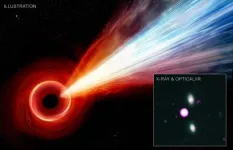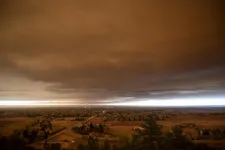(Press-News.org) Astronomers have discovered evidence for an extraordinarily long jet of particles coming from a supermassive black hole in the early universe, using NASA's Chandra X-ray Observatory.
If confirmed, it would be the most distant supermassive black hole with a jet detected in X-rays. Coming from a galaxy about 12.7 billion light-years from Earth, the jet may help explain how the biggest black holes formed at a very early time in the universe's history.
The source of the jet is a quasar - a rapidly growing supermassive black hole - named PSO J352.4034-15.3373 (PJ352-15 for short), which sits at the center of a young galaxy. It is one of the two most powerful quasars detected in radio waves in the first billion years after the big bang, and is about a billion times more massive than the Sun.
How were supermassive black holes able to grow so quickly to reach such an enormous mass in this early epoch of the universe? This is one of the key questions in astronomy today.
Despite their powerful gravity and fearsome reputation, black holes do not inevitably pull in everything that approaches close to them. Material orbiting around a black hole in a disk needs to lose speed and energy before it can fall farther inwards to cross the so-called event horizon, the point of no return. Magnetic fields can cause a braking effect on the disk as they power a jet, which is one key way for material in the disk to lose energy and, therefore, enhance the rate of growth of black holes.
"If a playground merry-go-round is moving too fast, it's hard for a child to move towards the center, so someone or something needs to slow the ride down," said Thomas Connor of NASA's Jet Propulsion Laboratory (JPL) in Pasadena, California, who led the study. "Around supermassive black holes, we think jets can take enough energy away so material can fall inward and the black hole can grow."
Astronomers needed to observe PJ352-15 for a total of three days using the sharp vision of Chandra to detect evidence for the X-ray jet. X-ray emission was detected about 160,000 light-years away from the quasar along the same direction as much shorter jets previously seen in radio waves by the Very Long Baseline Array. By comparison, the entire Milky Way spans about 100,000 light-years.
PJ352-15 breaks a couple of different astronomical records. First, the longest jet previously observed from the first billion years after the big bang was only about 5,000 light-years in length, corresponding to the radio observations of PJ352-15. Second, PJ352-15 is about 300 million light-years farther away than the most distant X-ray jet recorded before it..
"The length of this jet is significant because it means that the supermassive black hole powering it has been growing for a considerable period of time," said co-author Eduardo Bañados of the Max Planck Institute for Astronomy (MPIA) in Heidelberg, Germany. "This result underscores how X-ray studies of distant quasars provide a critical way to study the growth of the most distant supermassive black holes."
The light detected from this jet was emitted when the universe was only 0.98 billion years old, less than a tenth of its present age. At this point, the intensity of the cosmic microwave background radiation left over from the big bang was much greater than it is today.
As the electrons in the jet fly away from the black hole at close to the speed of light, they move through and collide with photons making up the cosmic microwave background radiation, boosting the energy of the photons up into the X-ray range to be detected by Chandra. In this scenario, the X-rays are significantly boosted in brightness compared to radio waves. This agrees with the observation that the large X-ray jet feature has no associated radio emission.
"Our result shows that X-ray observations can be one of the best ways to study quasars with jets in the early Universe," said co-author Daniel Stern, also of JPL. "Or to put it another way, X-ray observations in the future may be the key to unlocking the secrets of our cosmic past."
INFORMATION:
A paper describing these results has been accepted for publication in The Astrophysical Journal. The other co-authors of the paper are Chris Carilli (NRAO, Socorro, New Mexico); Andrew Fabian (University of Cambridge, UK); Emmanuel Momjian (NRAO); Sofía Rojas-Ruiz (MPIA); Roberto Decarli (INAF, Bologna, Italy); Emanuele Paolo Farina (Max Planck Institute for Astrophysics, Garching, Germany); Chiara Mazzucchelli (ESO, Chile); Hannah P. Earnshaw (Caltech, Pasadena, California).
NASA's Marshall Space Flight Center manages the Chandra program. The Smithsonian Astrophysical Observatory's Chandra X-ray Center controls science from Cambridge Massachusetts and flight operations from Burlington, Massachusetts.
Most teenagers don't remember life before the internet. They have grown up in a connected world, and being online has become one of their main sources of learning, entertaining and socializing.
As many previous studies have pointed out, and as many parents worry, this reality does not come risk-free. Whereas time on the internet can be informative, instructive and even pleasant, there is already significant literature on the potential harm caused by young children's problematic internet use (PIU).
However, a new study led by END ...
"It was clear that the greater an individual's sensitivity to motion parallax cues, the more severe the motion sickness symptoms," says lead NYU Abu Dhabi researcher
Fast facts:
The visual system is often studied in relative isolation, but it has clear connections to other components of the nervous system.
A notable example of this is motion sickness, which affects certain people much more severely than others.
Motion sickness is typically associated with traveling in cars, boats, and airplanes, however discomfort or "cybersickness" also arises with technological use such as in virtual reality (VR).
Abu Dhabi, UAE, March 9, 2021: A new study led by Head of the Rokers Vision Laboratory and NYUAD Associate Professor of Psychology Bas Rokers explored why ...
Non-Small Cell Lung Cancer (NSCLC) is the most prevalent form of lung cancer, accounting for more than 80 percent of all lung cancer cases. Despite the aggressive nature of NSCLC, circulating tumor cells that lead to metastases often go undetected in the blood compared to breast, prostate, colorectal, and other cancers.
Now, scientists have developed a novel method to better detect the circulating tumor cells (CTCs) that are a telltale sign of metastases. The research was published in the journal Proceedings of the National Academy of Sciences (PNAS).
ISB and a collaborative team of researchers looked at hexokinase-2, or HK2, a ...
A unique curved barrier has been designed by researchers at Imperial College London, who publish new findings in the peer-reviewed journal END ...
Researchers from the HealthPartners Institute and University of Minnesota in Minneapolis conducted an observational analysis of interviews and characteristics of primary care clinics, comparing the strategies, facilitators and barriers to high performance in treating patients with diabetes. The purpose of the study was to learn what strategies and factors seem most important to leaders of primary care clinics to ensure high performance. The percentage of Minnesota diabetes patients who achieved optimal diabetes care measures increased from 12 to 45 percent between 2004 and 2017, while national measures of diabetes care outcomes did not improve significantly around the same time ...
Smoke from local wildfires can affect the health of Colorado residents, in addition to smoke from fires in forests as far away as California and the Pacific Northwest.
Researchers at Colorado State University, curious about the health effects from smoke from large wildfires across the Western United States, analyzed six years of hospitalization data and death records for the cities along the Front Range, which reaches deep into central Colorado from southern Wyoming.
They found that wildfire smoke was associated with increased hospitalizations for asthma, chronic obstructive pulmonary disease and some cardiovascular health outcomes. They also discovered that wildfire smoke was associated with deaths from asthma and cardiovascular disease, but that ...
Researchers at Skoltech and their colleagues proposed a photonic device from two optical resonators with liquid crystals inside them to study optical properties of this system that can be useful for future generations of optoelectronic and spinoptronic devices. The paper was published in the journal Physical Review B.
The simplest kind of optical resonator consists of two mirrors directly opposite each other, "squeezing" light between them. When you stand inside a mirror resonator, you see infinite copies of yourself in the mirrors; when a liquid crystal - the kind in your computer and smartphone screen - is placed into a much smaller and a bit more complex resonator, ...
Cancer patients often experience fragmented care, particularly as they undergo cancer treatments. Although family physicians seek to provide continuous and comprehensive care, they often lose touch with their cancer patients during the treatment phase. Researchers conducted a randomized intervention that aimed to improve continuity of care and interprofessional collaboration as perceived by lung cancer patients and their family physicians.
The components of the intervention included the bidirectional exchange of patient information and care summaries between oncology teams and family physicians. Oncology ...
While many celebrate apple blossoms as classic signs of spring, they are also welcoming entry gates for pathogens. Full of nutrients to lure pollinators and promote pollen germination, flowers also attract bacteria like Erwinia amylavora, a pathogen that causes a damaging disease called fire blight. However, recent work by scientists at the Connecticut Agricultural Experiment Station suggests that these flowery infection sites might also be perfect targets for applying microbial fire blight biocontrol measures.
In a paper recently published in Phytobiomes Journal, researchers Zhouqi ...
LA JOLLA, CA--Translational research led by scientists at La Jolla Institute for Immunology (LJI) has resulted in a promising combination therapeutic candidate for adults with recent-onset type 1 diabetes.
The combination therapy was recently tested in a randomised, double-blind, placebo-
controlled, phase 2 trial run and funded by pharmaceutical company Novo Nordisk. The results, published recently in The Lancet Diabetes and Endocrinology, point to a potential way to treat the autoimmune disease without leaving the body vulnerable to infectious disease.
The therapeutic candidate combines anti-IL-21 antibody with the diabetes drug liraglutide. This ...







